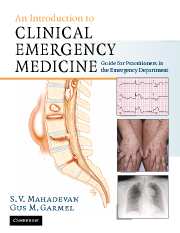Book contents
- Frontmatter
- Contents
- List of contributors
- Foreword
- Acknowledgments
- Dedication
- Section 1 Principles of Emergency Medicine
- Section 2 Primary Complaints
- Section 3 Unique Issues in Emergency Medicine
- Section 4 Appendices
- Appendix A Common emergency procedures
- Appendix B Wound preparation
- Appendix C Laceration repair
- Appendix D Procedural sedation and analgesia
- Appendix E Focused assessment with sonography in trauma
- Appendix F Interpretation of emergency laboratories
- Index
Appendix D - Procedural sedation and analgesia
Published online by Cambridge University Press: 27 October 2009
- Frontmatter
- Contents
- List of contributors
- Foreword
- Acknowledgments
- Dedication
- Section 1 Principles of Emergency Medicine
- Section 2 Primary Complaints
- Section 3 Unique Issues in Emergency Medicine
- Section 4 Appendices
- Appendix A Common emergency procedures
- Appendix B Wound preparation
- Appendix C Laceration repair
- Appendix D Procedural sedation and analgesia
- Appendix E Focused assessment with sonography in trauma
- Appendix F Interpretation of emergency laboratories
- Index
Summary
Scope of the problem
Procedural sedation and analgesia (PSA) represents one of the great advances in emergency medicine's maturation as a specialty. It has become a routine part of emergency medical practice, encompassing many fundamental clinical skills including airway assessment and management and critical resuscitation skills. PSA is very safe in the hands of a properly-trained practitioner in the correct setting with appropriate monitoring and resuscitation equipment.
Older terminology attempted to describe the state of sedation and analgesia in static terms, such as conscious sedation. This definition required that patients given agents providing both sedation and analgesia remained conscious, and were still able to reflexively protect their airways. The terminology has evolved to reflect the continuum upon which sedation and analgesia occur, ranging from anxiolysis to analgesia and light sedation through deep sedation and general anesthesia. All of these levels may be applied to the emergency department (ED) setting with the exception of general anesthesia; this implies a complete loss of consciousness and protective airway reflexes.
Certain ED procedures and studies commonly require PSA (Table D.1).
General treatment principles
The major considerations in selecting drugs for PSA include sedation, amnesia, analgesia and muscle relaxation. The first step is to determine the desired depth of sedation. A toddler who has sustained a minor head injury and is undergoing a computed tomography (CT) of the head requires much less sedation and essentially no analgesia when compared to a child who is having a burn debrided or a long bone fracture reduced.
- Type
- Chapter
- Information
- An Introduction to Clinical Emergency MedicineGuide for Practitioners in the Emergency Department, pp. 725 - 732Publisher: Cambridge University PressPrint publication year: 2005



